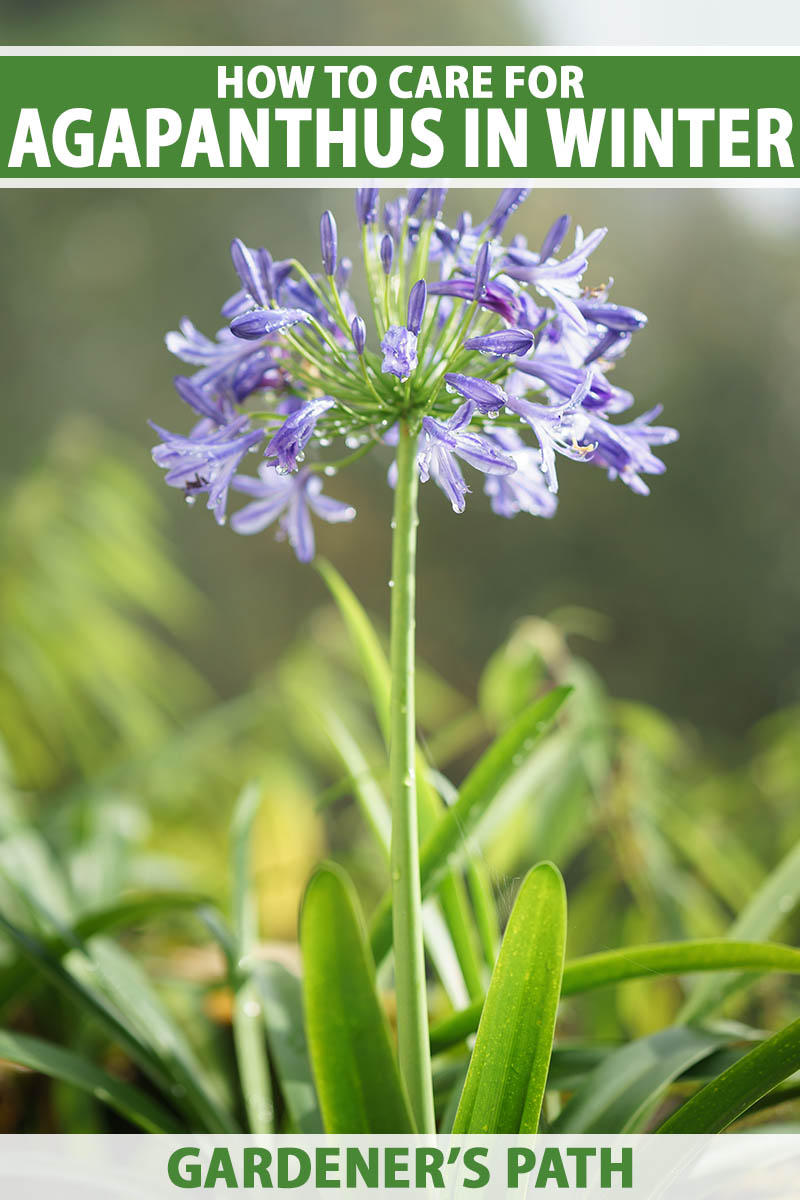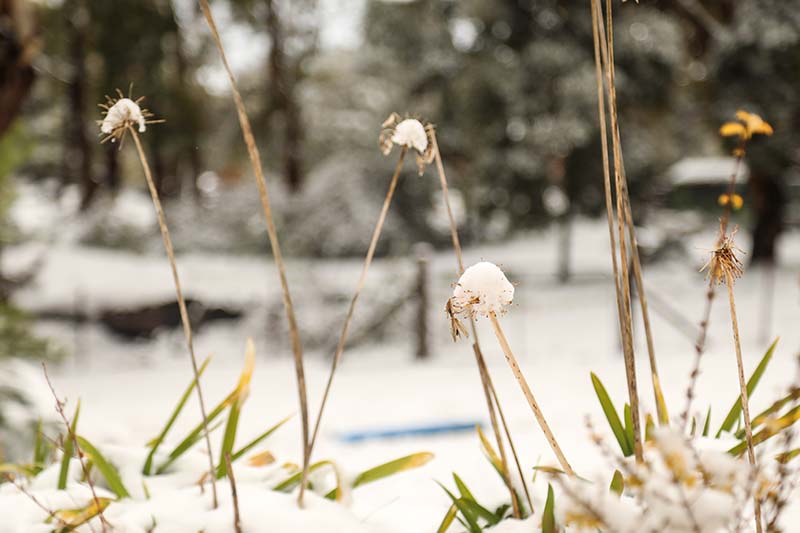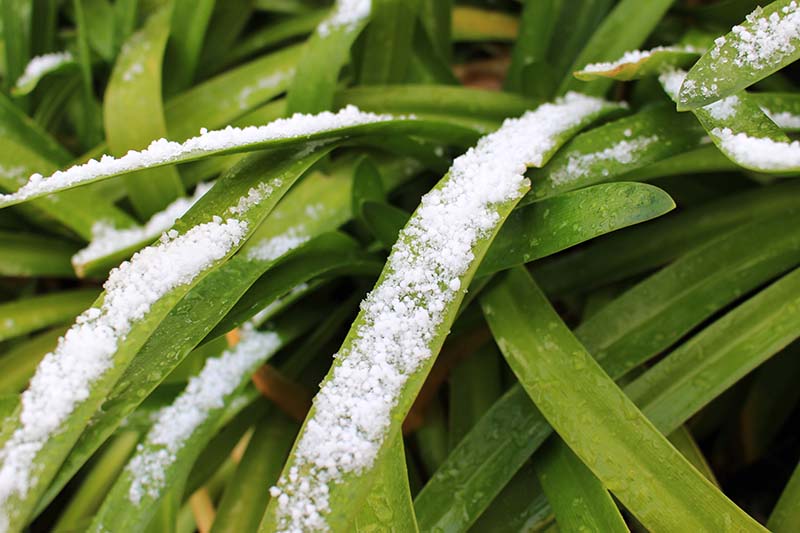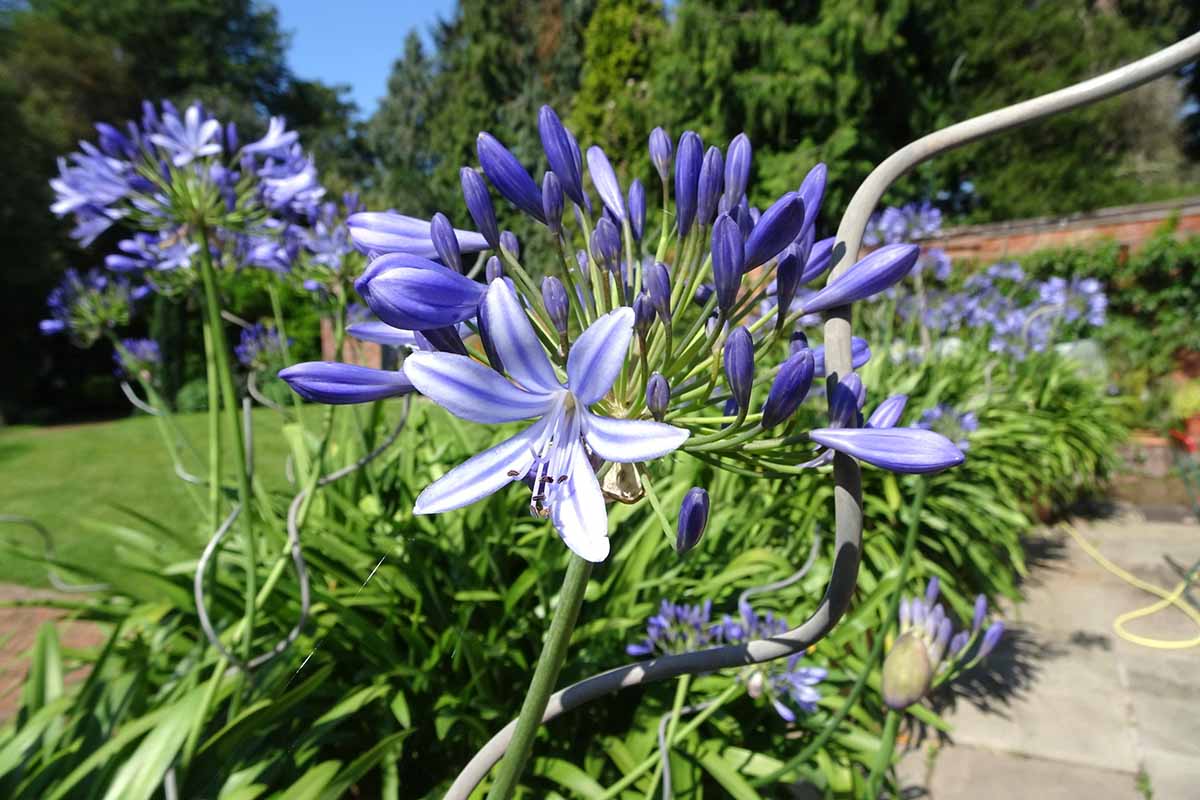Whenever I see a bright cluster of agapanthus, I think of sunshine, warmth, and tropical locales.
But these members of the amaryllis family may also need to deal with chilly wintertime temperatures – their growing zone suitability ranges from Zone 6 to Zone 11.
Deciduous varieties can weather conditions in Zone 6, with temperatures ranging all the way down to -10°F in the winter.
Evergreen varieties are less cold hardy, and are therefore more suited to cultivation Zones 8 and up. But even in Zone 8, winters can get cold, and freezing temperatures can strike even in locales in Zone 9.

We link to vendors to help you find relevant products. If you buy from one of our links, we may earn a commission.
Maybe you’re a rebel who planted some agapanthus in Zone 5, and you’re wondering if you can keep your lush, colorful plant alive throughout the winter. I know the feeling.
If you want to learn more about how to cultivate this unique plant, check out our growing guide. In this article, we’ll be focusing on keeping the plant warm during the cold winter months.
Here’s what you’ll discover:
How to Keep Agapanthus Happy in Chilly Weather
What Does Agapanthus Need During the Cold Months?
There are two things these plants do in winter, depending on the species.
Deciduous species go dormant, with their long, spade-like leaves dying back while the rhizomes are tucked under the soil, alive and well.

Evergreen species, on the other hand, keep their foliage throughout the winter and would prefer to stay warm, thank you very much.
The species you planted in your flowerbeds, inherited from a previous resident, or just picked up at the nursery should match up with your growing zone.
If you’re not sure if the variety in your garden is deciduous or evergreen, try this test: observe the plant closely as the days get shorter and colder in the fall.
Does it begin to die back, signaled to begin to go into dormancy by the fading light and chilly air? It’s probably deciduous.

If it stays green despite the colder air and lower light, then it may be an evergreen – which means you need to ramp up the winter protection ASAP!
Agapanthus has different winter care requirements, depending on whether you’ve got an evergreen or a deciduous variety, so we’ll split this guide accordingly.
Caring for Deciduous Plants in Winter
During the winter, deciduous varieties do best if temperatures remain consistently between 40 and 50°F.
Allow the leaves to die back naturally, so energy for next year will be stored in the rhizomes. When all the leaves turn brown and have died back, you can cut the stems back to four inches above the ground.
Since the plant has no leaves during the winter, there are no light requirements to follow until foliage begins to grow back again in the spring – at which point, it once again needs full sun in order to thrive.
According to experts at the New York Botanical Garden, you should water the soil once every two or three weeks during the winter – just enough so that it doesn’t go bone dry about four or five inches down.
This winter care will sustain deciduous agapanthus plants if they are growing in the ground in Zones 8 and 9.
Gardeners in Zones 6 and 7 will also need to apply a two- to three-inch layer of organic mulch in advance of the first frost.
Keep an eye on the weather in your area as well as the anticipated first frost date, and make sure to apply mulch if temperatures go below 40°F.
Shredded leaves, bark mulch, and straw are all good options.
Tips for Providing Extra Protection for Deciduous Varieties
Say your daredevil self is growing agapanthus in Zone 5. Or maybe you live in Zone 6, and you don’t trust mulch alone to keep your plant warm.
What can you do? Transplant it!
You can help your plant survive a colder winter by transplanting it into a container, and moving it to an insulated garage or basement for the winter.

You’ll first want to select a planter that’s 12 inches deep and 12 inches wide, with drainage holes. Add fresh, well-draining potting mix to the container, filling it about halfway.
Then, remove your agapanthus from its spot in your garden by using a trowel to mark out a perimeter that’s at least six inches away from the foliage.
Dig down around the entire perimeter, going about eight to 12 inches deep before slowly tugging the plant out.
Set it in its new container and add more potting mix, leaving an inch between the top of the soil and the lip of the pot.
Water thoroughly, making sure water runs out the bottom of the pot, and move the container to your insulated garage or basement that will ideally stay between 40 and 50°F.
We don’t recommend bringing deciduous agapanthus plants inside, however. Moving these into a warmer part of your home can prevent the plant from going dormant, which can affect its health and ability to bloom come springtime.
Once the days get longer and warmer in the spring, about two weeks after your area’s average last frost date, you can bring the plant back outside and either leave it in its container or move it back into its original planting area.
Keep in mind that transplanting your agapanthus more than once every three to four years can affect its ability to bloom, so you may want to leave it in a container indefinitely. This will make winter care easy every year!
Lifting Agapanthus to Store in Newspaper
You can also use the method mentioned above to lift the rhizomes, but instead of repotting them, you can store them in a dark, cool place with constant temperatures between 40 and 50°F.
To do this, you’ll line a cardboard box with newspaper and then fill it with a dry organic medium like coconut coir or sawdust.
After you lift the tuberous rhizomes, apply a sulfur powder to them to help prevent fungal infections, and then lay them in the newspaper-lined box. Store it in a cool, dark, dry area.
Lifting rhizomes in this way is common for many tender plants that may not be able to survive cold winters, such as dahlias and gladiolus. You can read more about the process in our guide to lifting dahlias for winter storage.
Just remember to put them back in the ground two weeks after your area’s average last frost date in the spring!
Caring for Evergreen Varieties in Winter
Unlike their deciduous counterparts, evergreen varieties don’t do well at all in Zones 6 or 7.
Instead, they’re suited to Zones 8 through 11, and during the winter, they still require full sun and temperatures no lower than 55 to 60°F, say the experts at the New York Botanical Garden.
If you live in an area where temperatures don’t drop below 55°F, there’s not much you need to do during the winter except water your plant less often, since it isn’t actively growing – once every week or week and a half should suffice.
Just don’t allow the soil to get bone dry two inches down.

Do keep an eye on the weather, though, to make sure you’re not caught off guard by a surprise cold snap.
If temperatures are predicted to remain below 55°F, you can add a two- to three-inch layer of mulch to the root area to help keep the plant insulated.
You can also pop a portable mini greenhouse over top of the plants to trap some heat and protect them from temperatures below 55°F. I like this one from Outsunny, available at the Home Depot.
If you accidentally planted an evergreen variety in your Zone 6 or 7 garden, don’t worry! You can move the agapanthus into a container and overwinter it indoors.
Follow the instructions for transplanting deciduous agapanthus into a container as described above, but add this important step: either set the plant near a window where it’ll get plenty of sunlight, or set up a grow light system and keep the lights trained on the foliage for 12 to 14 hours a day.
Make sure the lights are about one to two inches away from the plants.
Once transplanted, you may want to consider leaving your evergreen agapanthus in a pot for at least a few years.
Disturbing the roots more than once every three to four years can stress the plant and prevent it from blooming reliably.
Fearless Frosts
With a bit of extra care, your pretty plant will thrive during the winter and be ready for resplendent spring and summer seasons.

Have you ever tried overwintering agapanthus indoors or outside? We’d love to hear your tips, tricks, and tales in the comments below.
In the meantime, remember to check out these additional articles on growing agapanthus next:




I bought 4 agapanthus plants two years ago, not knowing anything about them at all – it was sheer love at first sight. Turns out they’re the evergreen variety. We left them under grow lights in our basement and they bloomed all winter long. I think they perhaps needed to go dormant ?? They didn’t bloom all summer (We live in zone 5 in Toronto) and have suddenly started blooming in October!! I’m looking for some advice as to what to do with them over the winter so that we can enjoy blooms next summer rather than in the basement.
Hi Karima, I totally understand! They’re pretty striking plants. You’re right, you should give these plants the chance to go dormant in the winter. At this point, let them finish blooming and then move them into a cooler spot with a little less light. You should also reduce the amount of water you give them compared to what they had in the summer. This will encourage them to go dormant. Don’t worry if you don’t get a chance to let them go dormant this year. They’ll survive, though they probably won’t bloom as well this year. Then, just let them… Read more »